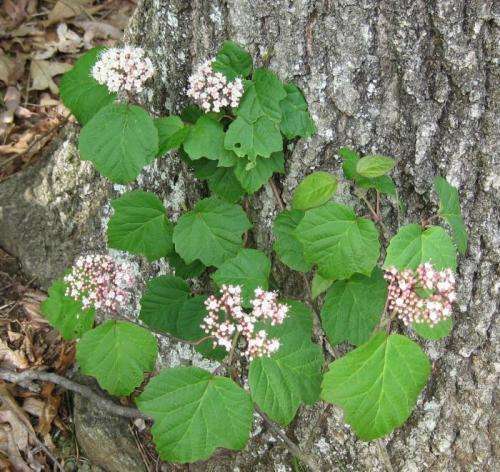New native shrubs show promise for landscape, nursery industries

As consumer interest in native plants increases, nursery growers are challenged to expand their product range by adding new native species to their collections. Surveys have indicated that landscape architects and master gardeners would like to use more native plants, but that a broad palette of native plants is not currently available from most growers. Growers looking to capitalize on the native plant market are looking to scientists to recommend new species suitable for the commercial nursery industry. In the August 2013 issue of HortScience, researchers Julia Cartabiano and Jessica Lubell from the Department of Plant Science and Landscape Architecture at the University of Connecticut report on their study of four native shrubs that are relatively unknown in the horticultural trade: Ceanothus americanus, Corylus cornuta, Lonicera canadensis, and Viburnum acerifolium. They said that these shrubs have the potential to become revenue generators for the nursery industry if successful propagation protocols are developed.
Cartabiano and Lubell evaluated the impact of cutting timing on propagation success of the four native shrubs. They found that timing had no significant effect on rooting percentage, root count, or root length of Corylus cornuta or Viburnum acerifolium. "Some growers have reported difficulty propagating Viburnim acerifolium," noted corresponding author Jessica Lubell. "However, we found it to be the easiest shrub to propagate of the four natives evaluated, and therefore it has the most obvious potential to be a mainstream nursery crop. Nearly 100% rooting can be achieved with V. acerifolium cuttings containing two nodes taken mid-June through mid-August."
Another standout in the study was Corylus cornuta, which the researchers said can be propagated at 85% rooting or greater when cuttings are taken mid-June to mid-August and treated with indole-3-butyric acid at 3000 ppm. "Our results indicated that Corylus cornuta, in addition to Viburnum acerifolium, has the potential to be a new nursery crop," Lubell said.
The study recommends that rooted cuttings of both Corylus cornuta and Viburnum acerifolium should be left in rooting containers for a period of cold dormancy before transplanting in order to optimize cutting survival. "Growers who overwinter their C. cornuta and V. acerifolium in the container in which they were rooted can expect close to 100% survival," noted Lubell. They advised that fall transplanting will likely result in 50% attrition, thus reducing the potential for the species to be viable in commercial nursery environments.
Cartabiano and Lubell said that, although Corylus cornuta and Viburnum acerifolium showed the most promise as commercially viable nursery crops, further propagation research could validate all four of the native species in the study as recommended crops for general wholesale nurseries.
More information: hortsci.ashspublications.org/c … t/48/8/1018.abstract
Journal information: HortScience
Provided by American Society for Horticultural Science














